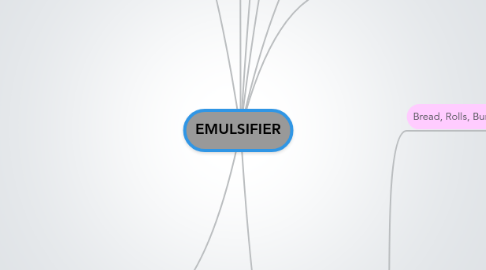
1. How does emulsifier work?
1.1. Reduce surface tension between 2 immiscible phases due to their molecular structure
1.2. Have both polar group with an affinity for water (hydrophilic) , and non-polar group with an affinity for oil (lipophilic)
1.3. Lipophilic tails---C16 (palmitic) or longer fatty acids
1.4. Polar head group---anionic, cationic, amphoteric, or nonionic functional group
1.5. Emulsifiers can orient at the phase interface and lower the interfacial energy that kead to instability
1.6. It stabilize emulsion by means of monomolecular interfacial film and also formation of steric and/or electrical barriers that prevent coalescenceof dispersed droplets
2. Types of emulsifier
2.1. Nonionic
2.1.1. Uncharged molecules, insensitive to pH and salt content
2.1.2. Examples : mono- and diglycerides, sorbitan esters, sucrose esters, polysorbates, polyoxyethylene glycol oleates (all contain -OH functional group)
2.2. Anionic
2.2.1. Possess a -ve charge
2.2.2. Examples : stearoyl lactylates, diacetyl tartaric esters of monoglycerides (DATEM), succinylated monoglycerides
2.2.3. Functionality- influenced by pH and ionic strength
2.3. Cationic
2.3.1. Possess a +ve charge
2.3.2. Example : amine compound
2.4. Amphoteric
2.4.1. Possess both +ve and -ve charges
2.4.2. Examples : various lecithin (may act as anionic/cationic emulsifier depend on pH of system)
3. Properties of some common food prpoerties
3.1. Mono- & Di-glycerides
3.1.1. High lipophilic with HLB values range from 1-10
3.1.2. Produced by transesterification of glycerola nad triacylcerides
3.1.3. Used in bakery products, frozen desserts, icings, toppings, peanut butter
3.2. Sucrose Esters
3.2.1. Mono-, di-, and tri- esters of sucose with fatty acids
3.2.2. HLB values from 7-13
3.2.3. Mono-esters have HLB>16 for o/w emulsion
3.2.4. Di-esters are good for w/o emulsion
3.2.5. Tri-esters have HLB~1
3.3. Sorbitan Esters
3.3.1. Sorbitan monostearate is the only sorbitan ester approved for food use
3.3.2. Produced by reaction of sorbitol+stearic acid
3.3.3. SPAN 60
3.3.4. HLB=4.7
3.3.5. Used in conjunction with polysorbates in oil toppings, cake mixes, etc
3.4. Polysorbates
3.4.1. Polyoxyethylene sorbitan esters
3.4.2. Formed from reaction of sorbitan esters with ethylene oxide
3.5. Polysorbate 60
3.5.1. Polyoxyethylene sorbitan monostearate or TWEEN 60
3.5.2. HLB=14.9
3.5.3. Used in oil toppings, cake mixes, cake icings
3.6. Polysorbate 65
3.6.1. Polyoxyethylene sorbitan tristearate or TWEEN 65
3.6.2. Used in ice cream, frozen custard, ice milk, etc
3.7. Polysorbate 80
3.7.1. Polyoxyethylene sorbitan monooleate or TWEEN 80
3.7.2. HLB=15.0
3.7.3. Used in special dietary foods, vitamin-mineral preparation, fat-soluble vitamins
3.8. Stearoyl Lactylates
3.8.1. Ionic emulsifier
3.8.2. Most hydrophilic emulsifiers used in food
3.8.3. Lactic acid ester of monoglyceride with sodium or calcium
3.8.4. Form strong complex with gluten in starch
3.8.5. Used in bakery products
3.9. Lecithin and derivatives
3.9.1. Amphipilic emulsifiers
3.9.2. Mixture of phospholipids including phosphatidyl choline, phosphatidyl ethanolamines, inositol phosphatides, etc
3.9.3. Rich in egg yolk
3.9.4. Derived from soybeans
3.9.5. Used in baked goods, low-fat baked goods, chocolate, instant foods, confectionary products, cooking spray
4. What is?
4.1. Emulsion
4.1.1. a dispersed 2-phase system, an intimate mixture of 2 liquids that are immiscible under normal conditions
4.1.2. One phase dispersed in the other in the form of fine doplets
4.1.3. Dispersed phase---dispersed droplets/inner phase
4.1.4. Continuous phase---medium in which droplets are dispersed
4.2. Emulsifier
4.2.1. Reduce the surface tension at the interface, allow 2 immiscible liquids to mix and form emulsion
4.2.2. surface-active agents or surfactants
5. Stability of emulsifier
5.1. Degree of division of the inner phase
5.2. Quality or stability of interfacial film
5.3. Viscosity of the outer phase
5.4. Ratio and specific weight of the volumes of the 2 phases
6. Functions
6.1. Promote emulsion stability, stabilize aerated system, control agglomeration of fat globules
6.2. Modify texture, shelf life, rheological properties by complexing with starch and protein components
6.3. Improve the texture of fat-based foods by controlling the polymorphism of fats
7. Application
7.1. Bread, Rolls, Buns
7.1.1. Dough conditioning/strengthening
7.1.1.1. Emulsifier that aid in development of less tacky, more extensible dough processed through machinery without tearing or sticking
7.1.1.2. Exert their effect during fermentation, mechanical handling, shaping, transport, during proofing and the first part baking time
7.1.1.3. Examples : calcium stearoyl lactylate, sodium stearoyl lactylate, polyoxyethylene sorbitan monostearate (PS 60), etc
7.1.2. Crumb-softening
7.1.2.1. Emulsifiers (anionic type) that complex with starch
7.1.2.2. interact with the flour components to create a longer lasting softness
7.1.2.3. Emulsifier-starch (spacially amylose) complex retard starch crystallization or retrogradation which is responsible for staling
7.1.2.4. Most effective softeners---lactylates and SMG, plastic mono- and diglycerides, DATEM
7.2. Cakes
7.2.1. Cake batters---complex o/w emulsions or air-in-fat foamms, consist of suspended flour particles, dissolved sugars, proteins
7.2.2. Emulsifiers added to fat-containing batters---stabilize aerated structure, promote finer distribution of fat droplets
7.2.3. Alpha-tending emulsifiers (acetic acid esters of monoglycerides, lactic acid esters of monoglycerides, etc)
7.2.4. Alpha-tending emulsifiers promote finer distribution of fat droplets, increase viscosity of water phase---higher volume and more uniform cell structure in finished product.
7.3. Confectionery Products & Coatings
7.3.1. Emulsifiers---inhibit bloom, stabilize gloss, improve palatibility
7.3.2. Bloom---occur when fat crystals undergo transition from beta' form to the most stable crystalline form, beta
7.3.3. distilled monoglycerides, lactic acid esters of monoglycerides, sorbitan monostearate and polysorbate 60
7.4. Frozen Dairy Products - Ice Cream
7.4.1. Emulsifiers---aerating agent and foam stabilizer
7.4.2. Emulsifier stabilize the foam by destabilizing the product's emulsion
7.4.3. It displace the protein from fat globule surface to the aqueous phase
7.4.4. This increase liquid cream's viscosity, allows fat globules to agglomerate
7.4.5. increased viscosity---promote aeration
7.4.6. Agglomeration---stabilize air cells once the air is incorperated
7.5. Noodle & Pasta
7.5.1. Emulsifiers---make a rigid complex with starch to protect starch granules, improve quality of starchy foods
7.5.2. Fresh noodles---emulsifier makes it easier to handle dough, increase water absorption rate. Surface of noodle become smooth, unoform, less sticky
7.5.3. Instant noodles---emulsifier improve absorption, decrease cooking time
7.5.4. Macaroni & Spaghetti- emulsifier provide feeling of elasticity, smooth uniform surface inhibits sticking after boiling
